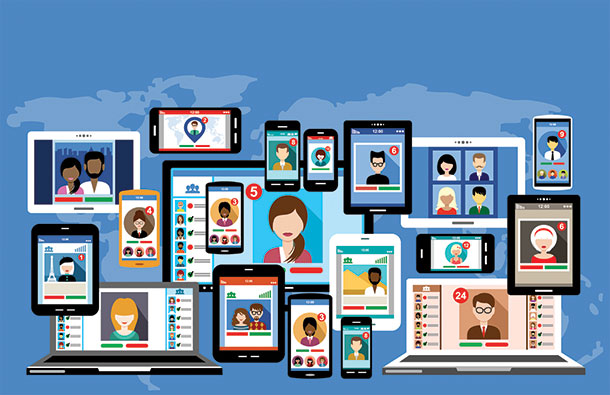Have you been “sharenting?”
The common practice of releasing a torrent of photos, videos, and stories of your children on social media can be difficult to resist. After all, they mean so much to you. “What kind of cold-hearted cretin wouldn’t want to see my 13th post in a day of little Jaxon’s romp in the autumn leaves?” you may be asking yourself.
But, even if your “sharenting” is welcomed by others — like, say, hundreds of thousands of followers — you might be creating an unwanted digital footprint for your child that they can’t even consent to yet. This concern is particularly timely after mommy bloggers, like the one who wrote recently in The Washington Post, have expressed dismay at their growing children’s reactions to having intimate details of their lives documented online.
While you may not have the wide internet reach of an Instagram influencer or a famous blogger, there are plenty of other privacy and safety concerns to consider when posting about your kids. For many of us, social media sites have become the main channel for storing our memories, but is there a better way?
Change Up the Apps
If you really want to hang on to your Facebook, there are some privacy changes you can make to better secure your family’s digital life. Making private photo albums and posts is a way to limit the people who see your content. Of course, you can’t have absolute control over the content once it is released, but you can feel better, perhaps, about who is seeing your pictures and stories.
Another app, called Keepy, was originally developed for saving and sharing kids’ artwork. The platform has grown, however, and the app can now be used for keeping a collection of pictures, videos, and voiceovers to share with loved ones. Grandparents, aunts, and friends can even leave their own “voice message” style comments, and the whole gallery can be viewed from any device.
If you like the “story” video form that has taken over social media sites of late, then you might be interested in Steller, an app that lets you combine photos, videos, and text into digital flipbooks that tell your story. You can then share your flipbooks via texting, e-mail, or virtually any other form of online communication. Steller is used largely for travel and marketing stories, but the burgeoning social media platform offers an easy way to tell your family’s stories and share them however you like.
A few apps now make it possible — and simple — to print your pictures in the most exciting ways. With Postagram, you can mail a personalized postcard to just about anywhere in the world for $2 domestically and $3 internationally. Send a vacation greeting, holiday card, or just a casual “hello” with your own pictures and text without messing with postage stamps. The app Recently sends you a magazine each month featuring your own photos. For about the price of a Netflix subscription, you can turn your beautiful iPhone or Android snapshots into a glossy zine where your family is always the cover story.
Go Primitive
Before Facebook and Instagram and even e-mail, there were still methods of saving family pictures and stories. People got creative, and they didn’t have to worry that their years of memories might disappear with the downfall of some app.
If you want to go old school with your archiving, spring for a vintage photo album like the offerings at MochiThings or Wayfair. Organizing and filling your albums could be a fun family activity, and you can display them prominently in your home where friends can peruse them at will. It may not give the immediate dopamine rush that you feel when those “likes” come rolling in on Facebook, but it could feel more lasting and special.
Another fun alternative to posting is to keep a memory jar somewhere handy in the house. Whenever a significant (or totally insignificant) memory is made, jot it down on a strip of paper and toss it in the jar. At the end of the year, you can read all of the experiences you had and put them somewhere safe.
For the long-winded among us, letter-writing can be an intimate proxy for blogging. A friend told me she writes regular letters to her toddler detailing the fun and troubles of the day. She plans to bundle them up and give them to him someday when he is able to read them. This could work on a weekly or even monthly basis. If you write daily letters to your tot, take into account the heavy lifting that will involve to gift it to them later, and consider paring them down occasionally.
What are your favorite ways to save memories, online or offline? Let us know in the comments.
Featured image: Shutterstock
Become a Saturday Evening Post member and enjoy unlimited access. Subscribe now




Comments
Even without “sharing” torrents of videos, photos and more on social media of any kind, a fundamental observation (to sane people) is that it’s too much, too anal, too neurotic, and being foisted on children too young to have a say in it. They may be going along with something they don’t understand, and might say no to if they did understand it.
Documenting and sharing everything, everyday gets old not to mention meaningless. The times we live in are very generic and non-descript as it is, unlike the decades in the 1900’s (excluding the first and last decades) where most decades had 2 or even 3 distinct sections.
But getting back to documenting a child’s life from morning to night everyday is overkill by any definition and putting the child at risk of sick, deranged people. It’s not unlike telling everyone online you’re on vacation, then being surprised your home was burglarized. Oh no! How could something like that have happened? I just don’t understand it! How could they?! I didn’t know people did awful things like that. This is America!
Option #3 of going vintage–not primitive, because it’s not, may be the best way to go. Remembering that less is more is helpful too. Modern life is overwhelming enough. Family pictures are something you can and should control, not being yet just another source of stress! Far fewer images, spread apart, sounds like a plan, and being kept more private. A lot more!